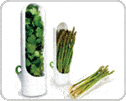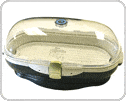
Written By: Gloria Tsang, RD
Title: Founding Registered Dietitian
Alumni: University of British Columbia
Last Updated on:

How many times have you found expired items in the fridge or pantry and thought, “Oh, I forgot to use/eat that up!”? Expired foods that get thrown out are a drain on your wallet as well as a waste of the precious resources that go into producing them. What are some tools to help us busy folks remember which leftovers are still fit for consumption?

Table of Contents
 One of the most fragile items in any produce drawer is fresh herbs. Prepara Herb Saver Pod is a product that helps you keep fresh herbs and fragile produce (such as cilantro and asparagus) longer. It has a removable basket to allow easy washing, and the bottom stopper is removable so you can drain off excess liquid and/or refill with fresh water. The container fits in the door of the fridge for easy access.
One of the most fragile items in any produce drawer is fresh herbs. Prepara Herb Saver Pod is a product that helps you keep fresh herbs and fragile produce (such as cilantro and asparagus) longer. It has a removable basket to allow easy washing, and the bottom stopper is removable so you can drain off excess liquid and/or refill with fresh water. The container fits in the door of the fridge for easy access.
 Not sure what to do with that onion half? There are products that act as covers on the cut surfaces of fruits or veggies, thereby reducing browning (that results from oxidation) or shrivelling (from moisture loss). These products can keep the cut piece fresher for an additional day or two, allowing you to use it in another recipe instead of throwing it away. Produce “covers” are available for cucumbers, onions, apples, and tomatoes.
Not sure what to do with that onion half? There are products that act as covers on the cut surfaces of fruits or veggies, thereby reducing browning (that results from oxidation) or shrivelling (from moisture loss). These products can keep the cut piece fresher for an additional day or two, allowing you to use it in another recipe instead of throwing it away. Produce “covers” are available for cucumbers, onions, apples, and tomatoes.
 Another type of product that claims to extend the shelf life of fresh fruits and vegetables are so-called “green bags”: bags that absorb the ethylene gas emitted by some produce as it ripens. Technically speaking, the bags should work to extend the shelf life of products that continue to ripen after they are picked, such as tomatoes, bananas, and melons. Items such as grapes or citrus fruits would not be affected much since they do not ripen further after being harvested. We tried this out on our own grocery items. In my case, a cut avocado did worse in the bag; I get more “mileage” out of it by rubbing a few drops of lemon juice on the cut surface and wrapping it tightly with plastic wrap.
Another type of product that claims to extend the shelf life of fresh fruits and vegetables are so-called “green bags”: bags that absorb the ethylene gas emitted by some produce as it ripens. Technically speaking, the bags should work to extend the shelf life of products that continue to ripen after they are picked, such as tomatoes, bananas, and melons. Items such as grapes or citrus fruits would not be affected much since they do not ripen further after being harvested. We tried this out on our own grocery items. In my case, a cut avocado did worse in the bag; I get more “mileage” out of it by rubbing a few drops of lemon juice on the cut surface and wrapping it tightly with plastic wrap.
 You can use containers that are supposed to optimize storage conditions for fresh produce so that it lasts longer in the fridge. They work by either keeping air out (therefore no oxygen to oxidize/break down the food inside) or managing moisture content (too much moisture causes mold, while too little causes shrivelling/wilting).
You can use containers that are supposed to optimize storage conditions for fresh produce so that it lasts longer in the fridge. They work by either keeping air out (therefore no oxygen to oxidize/break down the food inside) or managing moisture content (too much moisture causes mold, while too little causes shrivelling/wilting).
If your goal is to throw away less food, the above gadgets can help. But remember that we are talking about a shelf-life extension of days, not weeks. Fresh fruits and veggies that are stored for an extended period of time can lose a significant load of nutrients, so it’s best to purchase only what you can reasonably consume within days.
Alumni: University of British Columbia – Gloria Tsang is the author of 6 books and the founder of HealthCastle.com, the largest online nutrition network run by registered dietitians. Her work has appeared in major national publications, and she is a regularly featured nutrition expert for media outlets across the country. The Huffington Post named her one of its Top 20 Nutrition Experts on Twitter. Gloria’s articles have appeared on various media such as Reuters, NBC & ABC affiliates, The Chicago Sun-Times, Reader’s Digest Canada, iVillage and USA Today.
Toast William and Kate with British Royal Wedding Party Foods